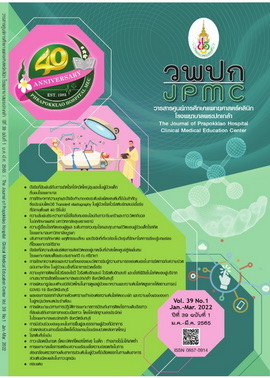การศึกษาความตรงและความเที่ยงของแบบวัดการรับรู้ความสามารถของตนเองในการจัดการกับความปวดฉบับภาษาไทย ในผู้ป่วยมะเร็งที่มีอาการปวดเรื้อรัง
Main Article Content
บทคัดย่อ
ที่มาของปัญหา: แบบวัดการรับรู้ความสามารถของตนเองในการจัดการกับความปวดฉบับภาษาไทย (PSEQ-Th) เป็นแบบสอบถามถูกพัฒนามาใช้กับผู้ป่วยที่มีอาการปวดเรื้อรังที่ไม่ได้เกิดมะเร็ง ซึ่ง PSEQ-Th สามารถนำไปใช้พยากรณ์พฤติกรรมที่เกี่ยวข้องกับความปวดได้ แต่ปัจจุบันยังไม่มีการศึกษาความน่าเชื่อถือเมื่อนำไปใช้ในกลุ่มผู้ป่วยมะเร็งที่มีอาการปวดเรื้อรัง
วัตถุประสงค์: เพื่อศึกษาความตรงและความเที่ยงของแบบวัดการรับรู้ความสามารถของตนเองในการจัดการกับความปวดฉบับภาษาไทยในผู้ป่วยมะเร็งที่มีอาการปวดเรื้อรัง
วิธีการศึกษา: ผู้ป่วยมะเร็งที่มีอาการปวดเรื้อรังที่มารับการรักษาที่ศูนย์ระงับปวด โรงพยาบาลศิริราชจะได้รับเชิญเข้างานวิจัย เพื่อตอบแบบสอบถาม 6 ชุดในครั้งแรก ประกอบไปด้วย Numeric Pain Rating Score (NPRS), Depression Anxiety Stress Scale-21 (DASS-21), Roland–Morris Disability Questionnaire (RMDQ), EuroQol Group-5 Dimensions-5 levels (EQ-5D-5L), Catastrophizing Score และ the PSEQ-Th และตอบแบบสอบถาม NPRS, PSEQ-Th ซ้ำอีกครั้งโดยห่างจากครั้งแรก อย่างน้อย 1 สัปดาห์
ผลการศึกษา: จากผู้เข้าร่วมวิจัยจำนวน 129 คน มีผู้ตอบแบบสอบถาม PSEQ-Th ในครั้งแรก 127 คนและครั้งที่ 2 จำนวน 113 คน ค่าเฉลี่ยของ PSEQ-Th ในครั้งแรกและครั้งที่ 2 เท่ากับ 38.8 (SD=14.6) และ 36.2 (SD=16.5) ตามลำดับ โดยมีค่าความเชื่อมั่น Cronbach’s alpha เท่ากับ 0.92 และ internal class coefficient เท่ากับ 0.55 จากการศึกษาพบว่า PSEQ-Th มีความสัมพันธ์เชิงลบกับ NPRS (r=-0.41), RMDQ (r=-0.44), DASS-21 (Stress part: r=-0.57, Anxiety part: r=-0.59, Depressive part: r=-0.63) และ Catastrophizing score (r=-0.51) แต่มีความสัมพันธ์เชิงบวกกับคุณภาพชีวิต (EQ-5D-5L: r=0.59)
สรุป: แบบสอบถาม PSEQ-Th เป็นแบบสอบถามที่มีความน่าเชื่อถือเมื่อนำไปใช้ในกลุ่มผู้ป่วยมะเร็งที่มีอาการปวดเรื้อรัง แบบสอบถาม PSEQ-Th มีความสัมพันธ์ในเชิงลบกับแบบวัด NPRS, RMDQ, DASS-21 และ Catastrophizing score อย่างมีนัยสำคัญทางสถิติ แต่มีความสัมพันธ์ในเชิงบวกกับคุณภาพชีวิต
Thaiclinicaltrials.org number, TCTR 20211216001
Article Details

This work is licensed under a Creative Commons Attribution-NonCommercial-NoDerivatives 4.0 International License.
References
Inoue S, Kobayashi F, Nishihara M, Arai YC, Ikemoto T, Kawai T, Inoue M,et al. Chronic pain in the Japanese community-prevalence,characteristics and impact on quality of life. PLoS One [Internet]. 2015[cited 2021 Sep 14];10(6):e0129262.Available from: https://journals.plos.org/plosone/article/file?id=10.1371/journal.pone.0129262&type=printable
van den Beuken-van Everdingen MH, Hochstenbach LMJ, Joosten EAJ, Tjan-HeijnenVCG, Janssen DJ. Update on prevalence of pain in patients with cancer: systematicreview and meta-analysis. J Pain Symptom Manage 2016;51:1070-90.e9
Nicholas MK. The pain self-efficacy questionnaire: taking pain into account.Eur J Pain2007;11:153-63.
Kalapurakkel S, Carpino EA, Lebel A, Simons LE. "Pain Can't Stop Me":examining pain self-efficacy and acceptance as resilience processes among youthwith chronic headache. J PediatrPsychol2015;40:926-33.
Yazdi-Ravandi S, Taslimi Z, Jamshidian N, Saberi H, Shams J, Haghparast A.Prediction of quality of life by self-efficacy, pain intensity and pain durationin patient with pain disorders. Basic ClinNeurosci 2013 Spring;4:117-24.
Adachi T, Nakae A, Maruo T, Shi K, Shibata M, Maeda L, et al.Validation of the Japanese version of the pain self-efficacy questionnaire inJapanese patients with chronic pain. Pain Med. 2014;15:1405-17.
Van der Maas LCC, de Vet HCW, Köke A, Bosscher RJ, Peters ML. Psychometric properties of the pain self-efficacy questionnaire (PSEQ) validation, prediction, and discriminationquality of the Dutch version. Eur J Psychol Assess 2012;28:68–75.
Ferreira-Valente MA, Pais-Ribeiro JL, Jensen MP. Psychometric properties ofthe portuguese version of the pain self-efficacy questionnaire. ActaReumatolPort 2011; 36(3):260-7.
Chiarawattanavit W. Validity and reliability of the Pain Self - Efficacy questionnaire Thai version (Th - PSEQ) in chronic noncancer pain patients [disertation]. Bangkok: Mahidol University; 2018.
Coker AO, Coker OO, Sanni D. Psychometric properties of the 21 - item Depression Anxiety Stress Scale (DASS - 21). Afr Res Rev 2018;12:135-42
Lee Y, Lin PY, Hsu ST, Cing-Chi Y, Yang LC, Wen JK. Comparing the use of the Taiwanese depression questionnaire and beck depression inventory for screeningdepression in patients with chronic pain. Chang Gung Med J 2008;31:369-77.
Asghari A. Psychometric properties of a modified version of the Roland-Morrisdisability questionnaire (M-RMDQ). Arch Iran Med 2011;14:327-31.
Sonsa - ardjit N, Sakthong P. Reliability and validity of the Thai version of EQ - 5D - 5L questionnaire on patients with chronic disease. Chula Med J 2015; 59:489-501.
Youngcharoen P, Aree - Ue S, Saraboon Y. Validation of pain catastrophizingscale - Thai version in older adults with knee osteoarthritis. Pac Rim Int J Nurs Res [Internet].2018 [cited 2021 Sep 14];22:237–48. Available from: https://he02.tci - thaijo.org/index.php/PRIJNR/article/view/91289
Leaungsomnapa Y, Prasertsri N, Chaiyasung P, Suworawatanakul W, Sananpanichkul P. Pain catastrophizing: concept and application to pain research in Thailand. J PrapokklaoHospClin Med Educat Center2015;32:256–69.
Sapnas KG, Zeller RA. Minimizing sample size when using exploratory factoranalysis for measurement. J NursMeas 2002 Fall;10:135-54.
Bobak CA, Barr PJ, O'Malley AJ. Estimation of an inter-rater intra-class correlation coefficient that overcomes common assumption violations in the assessment of health measurement scales. BMC Med Res Methodol. [Internet] 2018[cited 2021 Sep 14];18:93. Available from: https://bmcmedresmethodol.biomedcentral.com/track/pdf/10.1186/s12874-020-01117-5.pdf
Paiva CE, Barroso EM, Carneseca EC, de Pádua Souza C, Dos Santos FT, MendozaLópez RV, et al. A critical analysis of test retest reliability ininstrument validation studies of cancer patients under palliative care: asystematic review. BMC Med Res Methodol.[Internet] 2014 [cited 2021 Sep 14];14:8. Available from: https://bmcmedresmethodol.biomedcentral.com/track/pdf/10.1186/1471-2288-14-8.pdf
